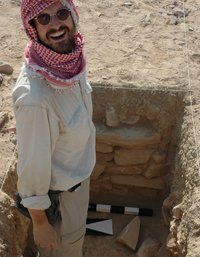Affiliation: Memorial University of Newfoundland

Milorad Nikolic is Associate Professor of Classics with the Memorial University of Newfoundland, and he holds his degrees from the University of Victoria (Ph.D.), the University of Calgary (M.A.), the University of Oldenburg (M.Sc.), the University of Applied Sciences in Osnabrück, and Coventry Polytechnic. Though he is a Professor of Classics, he is also trained as a mechanical engineer with a specialization in fluid mechanics and a physicist with a specialization in renewable energies. His area of specialization is ancient technology, particularly the water supply systems of ancient Greece and Rome, and more recently on the ancient view of water as a physical substance.
Aqueducts were vital to the existence of ancient Greek and Roman cities. The ancient builders had to design and maintain the pipelines without the aid of computer simulation and without remote-monitoring systems. Yet, the success of these cities and the survival of their aqueducts is testament to the ability of the builders to design these structures properly and to keep them in good operating condition.
It is the first century CE. The governor of the fictitious Roman province Terra Nova has tasked us to supply the equally fictitious town of Milopolis with water. We will follow the steps involved in building an aqueduct, from the exploration of a suitable source to the final distribution in the urban centre, by following the scant information in the works of Vitruvius, Frontinus, and Pliny, as well as clues from inscriptions and archaeological remains.
Short bibliography and/or website on lecture topic:
Hodge, A.T. 2002. Roman Aqueducts and Water Supply. London: Duckworth.
Wikander, Ö. 2000. Handbook of Ancient Water Technology. Leiden: Brill.
Technical and scientific texts from antiquity are notoriously difficult to translate. Portions of Vitruvius’s de architectura are a case in point. Book 8 on water supply contains particularly confusing passages that have prompted some modern scholars to suggest that Vitruvius had no idea what he was writing about. While the Latin of de architectura is by no means the most elegant prose, such judgment appears inaccurate. Vitruvius adopted much of his information in relation to water pipes from the Greek sources and models he was using, and a good part of the technical terminology is derived from parts of the body and their function. A multi-layered problem emerges as we try to understand Vitruvius’s explanation of the function of ancient aqueducts: Vitruvius’s translation from Greek into Latin describes unknown devices performing an unknown function, sometimes using untranslatable words, such as the ominous colluviaria, and other terms with a vaguely anatomical origin One thing in our favour is the mechanical behaviour of water, which has not changed since ancient Roman times. By investigating the surviving remains of aqueducts and observing the function of analogous parts of the human body, we may be able to explain the meaning of the more obscure passages.
Short bibliography and/or website on lecture topic:
Nikolic. “An Investigation of Vitruvius’ Technical Vocabulary Relating to Water Conduits and Pipelines in De arch. 8.6.6-9: geniculus and libramentum (re)examined.” Hermes 139 (4) (2011) 443-53.
Nikolic. “An Investigation of Vitruvius’ Technical Vocabulary Relating to Water Conduits and Pipelines in De arch. 8.6.6-9: vis spiritus and colluviaria (re)examined.” Mnemosyne 64 (2011) 424-46.
M Schwarz. “Neue Forschungsergebnisse zu Vitruvs colliviaria.” in C. Ohlig (ed.), Cura Aquarum in Jordanien. Siegburg: DWhG, 2008, 353-8.
In the past decades a trend has emerged in classical archaeology to re-examine the conspicuous remains of ancient structures from an engineering point of view. The Hellenistic and Roman aqueducts are a prominent example. Although crucial to the very existence of cities, the exact function of some features found in ancient aqueducts is still poorly understood. Mysterious towers, for example, that were built at considerable expense in material and labor into the pipelines of systems such as those at Aspendos or Craponne have puzzled modern scholars for over a century. Other pipelines, such as those at Pergamum, Smyrna, or Alatri, were deliberately laid out to incorporate intermediate hills into their course. Relevant ancient literary sources such as Vitruvius, Pliny the Elder, and Frontinus have been studied carefully in search for answers to the technical problems, but without significant success. More recently, constantly improving computer performance has made it possible to simulate these water-supply systems with commercially available Computational Fluid Dynamics (CFD) software packages. The application of this most recent computer-aided engineering tool to a number of ancient pipelines can yield insights into Hellenistic and Roman technology that go far beyond any explanation based on Vitruvius, Frontinus, or Pliny, and represents a transformation in the manner in which research in classical archaeology is conducted.
Short bibliography and/or website on lecture topic:
Kessener H. P. M. 2016. “The Aspendos Siphon and Roman Hydraulics,” in Wiplinger G. (ed), De Aquaeductu atque Aqua Urbium Lyciae Pamphiliae Pisidiae. Leiden: BABESCH Supplement 27.
Ortloff, C. R. and D. P. Crouch. 2001. “The Urban Water Supply and Distribution System of the Ionian City of Ephesos in the Roman Imperial Period.” Journal of Archaeological Science 28: 843-60.
Ortloff, C. R. and A. Kassinos. 2003. “Computational Fluid Dynamics Investigation of the Hydraulic Behaviour of the Roman Inverted Siphon System at Aspendos, Turkey.” Journal of Archaeological Science 30: 417-28.